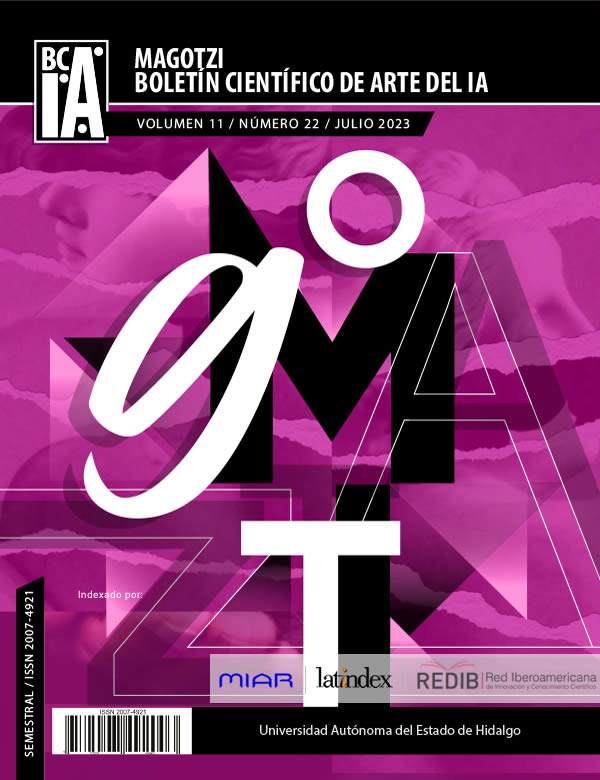Music Reading And The Complexity In The Score
An Ecological Validation Model For Complexity Measurements In Written Music
Abstract
We present a model that allows the content of the score to be divided automatically, based on the latest insights in music reading, cognition, and complexity. By relating “perceptual breadth” and “working memory”, we are able to find precise thresholds, which can be used to assess the complexity of music reading. The model conforms to the ecological validity requirements for the calculations that evaluate the complexity in written music and the validation shows that it is applicable to easy and difficult fragments written with musical notation.
Downloads
References
Angeler, D. G. (2020). Biodiversity in Music Scores. Challenges, 11(1), 7. https://doi.org/10.3390/challe11010007
Ávila Cascajares, F. S. (2021). Capacidad de memoria y estrategias de instrumentistas y no músicos en pruebas auditivas de Sternberg modificadas con unidades significativas musicales y verbales. Tesis de maestría en cognición musical: UNAM.
Bennett, D., Gobet, F., & Lane, P. C. R. (2020). Forming Concepts of Mozart and Homer Using Short-Term and Long-Term Memory: A Computational Model Based on Chunking. In S. Denison, M. Mack, Y. Xu, & B. C. Armstrong (Eds.), Proceedings of the 42th Annual Meeting of the Cognitive Science Society—Developing a Mind: Learning in Humans, Animals, and Machines, CogSci 2020, virtual, July 29—August 1, 2020.
Burman, D. D., & Booth, J. R. (2009). Music Rehearsal Increases the Perceptual Span for Notation. Music Perception, 26(4), 303–320. https://doi.org/10.1525/mp.2009.26.4.303
Chang, T.-Y., & Gauthier, I. (2021). Domain-specific and domain-general contributions to reading musical notation. Attention, Perception, & Psychophysics. https://doi.org/10.3758/s13414-021-02349-3
Chase, I. D. (2006). Music notation: A new method for visualizing social interaction in animals and humans. Frontiers in Zoology, 3(1), 18. https://doi.org/10.1186/1742-9994-3-18
Chitalkina, N., Puurtinen, M., Gruber, H., & Bednarik, R. (2020). Handling of incongruences in music notation during singing or playing. International Journal of Music Education, 39(1), 18–38. https://doi.org/10.1177/0255761420944036
Dover publications. (1983). Ludwig van Beethovens Werke, Serie 9, Nr.67. Leipzig: Breitkopf und Härtel, n.d.[1862]. Plate B.67. dominio público, acceso desde https://imslp.org/wiki/Piano_Concerto_No.3%2C_Op.37_(Beethoven%2C_Ludwig_van), acceso 2022-01-01.
Eden Ünlü, S., & Ece, A. S. (2019). Reading notation with Gestalt perception principles: Gestalt algı ilkeleri ile notasyon okuma. Journal of Human Sciences, 16(4), 1104–1120. https://doi.org/10.14687/jhs.v16i4.5822
Gunter, T. C., Schmidt, B.-H., & Besson, M. (2003). Let’s face the music: A behavioral and electrophysiological exploration of score reading. Psychophysiology, 40(5), Article 5. https://doi.org/10.1111/1469-8986.00074
Hattie, J. (2008). Visible learning: A synthesis of over 800 meta-analyses relating to achievement. Routledge.
Holder, E., Tilevich, E., & Gillick, A. (2015). Musiplectics: Computational assessment of the complexity of music scores. 2015 ACM International Symposium on New Ideas, New Paradigms, and Reflections on Programming and Software (Onward!) - Onward! 2015, 107–120. https://doi.org/10.1145/2814228.2814243
Ishiguro, Y., & Rekimoto, J. (2011). Peripheral vision annotation: Noninterference information presentation method for mobile augmented reality. Proceedings of the 2nd Augmented Human International Conference on - AH ’11, 1–5. https://doi.org/10.1145/1959826.1959834
Janurik, M., Surján, N., & Józsa, K. (2022). The Relationship between Early Word Reading, Phonological Awareness, Early Music Reading and Musical Aptitude. Journal of Intelligence, 10(3), 50. https://doi.org/10.3390/jintelligence10030050
Laske, O. E. (1988). Introduction to Cognitive Musicology. Computer Music Journal, 12(1), 43. https://doi.org/10.2307/3679836
Lerdahl, F., & Jackendoff, R. (1983). A generative theory of tonal music. MIT Press.
Lopes, A. M., & Tenreiro Machado, J. A. (2019). On the Complexity Analysis and Visualization of Musical Information. Entropy, 21(7), 669. https://doi.org/10.3390/e21070669
Malbrán, S. (2007). El oído de la mente. Akal.
McConkie, G. W., & Rayner, K. (1975). The span of the effective stimulus during a fixation in reading. Perception & Psychophysics, 17(6), 578–586. https://doi.org/10.3758/BF03203972
Mills, J., & McPherson, G. E. (2015). Musical literacy: Reading traditional clef notation. En McPherson, G. E. (Ed.), The Child as Musician (pp. 177–191). Oxford University Press. https://doi.org/10.1093/acprof:oso/9780198744443.003.0009
Morgan, E., Fogel, A., Nair, A., & Patel, A. D. (2019). Statistical learning and Gestalt-like principles predict melodic expectations. Cognition, 189, 23–34. https://doi.org/10.1016/j.cognition.2018.12.015
Pease, A., Mahmoodi, K., & West, B. J. (2018). Complexity measures of music. Chaos, Solitons & Fractals, 108, 82–86. https://doi.org/10.1016/j.chaos.2018.01.021
Puurtinen, M. (2018). Eye on Music Reading: A Methodological Review of Studies from 1994 to 2017. Journal of Eye Movement Research, 11(2). https://doi.org/10.16910/jemr.11.2.2
Schultz, M. (1998). La notación musical desde la perspectiva semiótica. Arte e Investigación, 2(2), 44–47.
Sheridan, H., & Kleinsmith, A. L. (2021). Music reading expertise affects visual change detection: Evidence from a music-related flicker paradigm. Quarterly Journal of Experimental Psychology, 174702182110569. https://doi.org/10.1177/17470218211056924
Silva, S., & Castro, S. L. (2019). The time will come: Evidence for an eye-audiation span in silent music reading. Psychology of Music, 47(4), 504–520. https://doi.org/10.1177/0305735618765302
Sloboda, J. A. (1976). The effect of item position on the likelihood of identification by inference in prose reading and music reading. Canadian Journal of Psychology/Revue Canadienne de Psychologie, 30(4), Article 4. https://doi.org/10.1037/h0082064
Stenberg, A., & Cross, I. (2019). White spaces, music notation and the facilitation of sight-reading. Scientific Reports, 9(1), Article 1. https://doi.org/10.1038/s41598-019-41445-1
Stewart, L. (2005). A Neurocognitive Approach to Music Reading. Annals of the New York Academy of Sciences, 1060(1), Article 1. https://doi.org/10.1196/annals.1360.032
Valle, F. (1985). El problema de la validez ecológica. Estudios de Psicología, 6(23–24), 135–151. https://doi.org/10.1080/02109395.1985.10821439
Viljoen, J. F., & Foxcroft, C. (2020). Gaze Patterns of Skilled and Unskilled Sight Readers Focusing on the Cognitive Processes Involved in Reading Key and Time Signatures. International Journal of Humanities and Social Sciences, 14(9), 764–767. https://publications.waset.org/vol/165
Weiss, C., Balke, S., Abeßer, J., & Müller, M. (2018). Computational Corpus Analysis: A Case Study on Jazz Solos. https://doi.org/10.5281/ZENODO.1492439
Copyright (c) 2023 Patricio Calatayud, Pablo Padilla Longoria, María del Mar Galera-Núñez, Gabriela Pérez-Acosta

This work is licensed under a Creative Commons Attribution-NonCommercial-NoDerivatives 4.0 International License.












